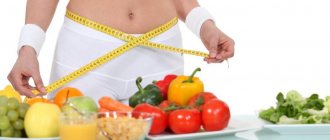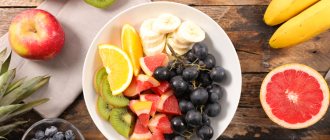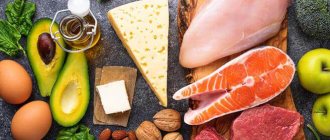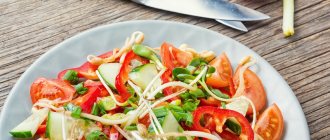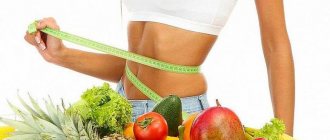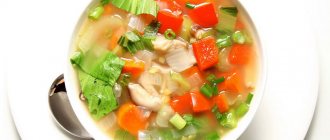Food allergies affect 1–3% of the adult population and about 8% of children, and at least 10% of the population experience food intolerance.
While an allergic reaction is usually obvious, recognizing intolerance is difficult. For example, symptoms may include a rash on the face or a headache.
We are talking about an elimination diet that will help identify sensitivity to any foods.
Products that most often cause allergies and food intolerances: milk, seafood, eggs, soy, fish, wheat, nuts Audio version of the article
What is an elimination diet?
This diet plan, in combination with drug treatment, ensures long-term remission by eliminating chemical irritants that cause allergic reactions, provoking the development of edema and inflammation.
An elimination diet is a special therapeutic diet of relatively short duration. It contains no food ingredients that cause unwanted reactions of the immune system and gastrointestinal tract.
At the final stage of the diet, excluded products are added to the menu one at a time to determine their tolerance by the body. During the elimination period, the diet contains only chemically neutral foods.
A comprehensive nutrition program helps quickly identify chemical irritants to which you are hypersensitive. The point of such a diet is to facilitate and accelerate natural detoxification mechanisms.
With allergic diseases, they are in a depressed state, and the removal of toxins is greatly slowed down. An elimination nutrition program usually lasts 2-3 weeks. During this time, allergic and inflammatory symptoms significantly weaken.
Herbal medicine with exclusionary nutrition↑
Since the diet is based on limiting food, the body is constantly under stress and lacking nutrients. The following plants will help reduce the negative effects of an elimination diet:
- licorice, elecampane, horsetail and yarrow will help reduce allergic reactions;
- Lingonberries, chestnuts, mallow, licorice, sweet clover will relieve swelling, normalize the functioning of the lymphatic system, and relieve skin itching;
- elecampane, burdock, Jerusalem artichoke will accelerate the elimination of toxins;
- Echinacea and Eleutherococcus, Leuzea, Aralia will support the immune system;
- chamomile, immortelle, artichoke, milk thistle will protect the liver and normalize its function;
- oregano, calendula, tansy, sage, kelp will restore the functions of the gastrointestinal tract.
Indications
An elimination nutrition program is prescribed for therapeutic purposes for celiac disease and impaired intestinal motility. It is effective for chronic inflammatory pathologies of the kidneys and urinary system.
An elimination nutrition regimen is indicated for patients with impaired intestinal motility. It is used to suppress the symptoms of seasonal exacerbations of chronic inflammatory pathologies.
Clinical indications for prescribing an elimination diet:
- atopic dermatitis;
- Quincke's edema;
- cross food allergies;
- bronchial asthma;
- hives;
- hay fever;
- gluten enteropathy;
- glucose-galactose malabsorption;
- high degree of intoxication of the body;
- liver dysfunction;
It is prescribed when there is a clinically proven role of a certain food product in increasing blood pressure, increasing the concentration of cholesterol in the blood, or developing urinary or cholelithiasis.
A therapeutic nutrition program often has a diagnostic purpose. It is prescribed to clarify the list of products and chemical compounds that provoke anaphylactic reactions when the information content of standard laboratory allergy tests is low.
Diet for nursing mothers - menu for infants intolerant to dairy products
Often it is enough to exclude all dairy products from the diet during breastfeeding. A balanced diet is possible without consuming dairy products to ensure good lactation, as evidenced by expert reviews. There is a lot of protein in fish, beef, chicken, eggs, nuts and legumes. Calcium-fortified soy milk, rice, almond or coconut milk, hemp milk, fortified orange juice may be allowed to ensure 1000 mg of calcium each day, calcium supplements and multivitamins are prescribed as needed (although these may contain hidden allergens).
If there is no sign of improvement after a month of an elimination diet, or even any symptom worsens, then other foods (wheat, soy, eggs, peanuts or tree nuts) may need to be eliminated. This is because a baby may be allergic to more than one food and may need to remain on an elimination diet for as long as breastfeeding continues. When breastfeeding ends or by the age of one year, it can be assumed that the baby will outgrow his food allergy.
Basic principles of nutrition
Treatment of chronic pathologies of allergic origin requires correction of the diet with the elimination of chemical irritants that provoke anaphylactic reactions. Without this, drug treatment does not give the expected effect.
This approach is especially effective for drug, food and inhalation anaphylaxis. The basic principle of diet correction is to exclude foods with etiologically significant allergenic substances.
It is replaced with a chemically neutral and well-accepted product with a similar protein content and identical energy value. This diet is aimed at reducing immune hyperactivity and providing the body with the necessary nutrients.
An elimination diet is a nutritional system that contains only fresh foods of natural origin.
It does not use:
- shelf-stable dishes;
- chemical flavor enhancers;
- preservatives;
- synthetic dyes.
When forming the menu, cross-influence and compatibility of products are taken into account. The biogenic properties of dishes change significantly during heat treatment and freezing.
Advantages and disadvantages
The diagnostic value of such a diet lies in the detection of previously unknown allergens. An elimination diet reduces or completely eliminates intestinal irritation and dyspeptic symptoms. They can occur even when eating natural foods in moderation.
Other benefits of an elimination diet:
- financial inclusion;
- simplicity and speed of cooking;
- physiologically complete diet;
- individual approach to identifying allergens;
- increasing the duration of remission in chronic inflammatory and anaphylactic pathologies;
- versatility and independence from gender, age, patient history;
- reduction of body intoxication;
- balanced nutrition enriched with nutrients.
This food system has minimal disadvantages. These include a limited diet, the need to constantly coordinate the menu with a gastroenterologist or nutritionist.
Diet stages
Elimination nutrition can be strict or liberal.
Elimination Diet Stages
It depends on the:
- focus of the diet – therapeutic, diagnostic, preventive;
- severity of clinical symptoms;
- the nature of the pathological disorder;
- frequency of exacerbations;
The therapeutic and diagnostic diet consists of 3 consecutive stages - preparation, exclusion diet, reintroduction. An important factor in menu planning is cross-response.
It is based on the antigenic similarity of the properties of the products consumed. The cross-reaction effect occurs when the sequence of amino acid compounds in the protein fractions of allergenic substances is 70% identical.
When an anaphylactic irritant is identified, products containing ingredients that enter into a pathogenic chemical interaction with it are excluded from the elimination diet.
Preparation
This stage begins with 3 fasting days to remove waste and toxins from the body. Drinking plenty of fluids is recommended. Pure water or green tea is suitable. It is necessary to free the body from the maximum possible amount of glucose.
It promotes the development of fungal microflora, the waste products of which are potent provocateurs of allergic reactions. High-protein foods are excluded from the diet.
They are saturated with known etiologically significant food allergens. Cereals, legumes, and nuts are saturated with such substances. Cleansing the body of toxins, waste and other harmful substances aims to create favorable conditions for the transition to the next stage of the diagnostic and treatment diet.
Elimination
This stage is aimed at identifying an unidentified provocateur of allergic reactions, exacerbations of chronic diseases and inflammatory processes. All products containing chemical compounds with known and clinically proven allergenic properties are removed from the diet.
The elimination diet at this stage is gentle and involves avoiding potentially allergenic foods and food additives. At this time, methods of culinary processing of ingredients become especially important.
Acceptable cooking methods:
- stewing;
- cooking;
- steam bath;
- baking;
- grill.
Dishes are eaten unsalted. Sodium chloride disrupts blood circulation, increases the fragility of vascular walls and blood pressure. It weakens bone fibers by leaching calcium from them.
Table salt is especially dangerous for people with cardiovascular diseases, gastrointestinal pathologies, and neurological disorders. Therefore, it is excluded from the elimination diet.
Food seasonings are a known allergenic factor. Spices and herbs are not used in therapeutic and diagnostic nutrition. During the elimination phase, food should be eaten in small portions, but often - 5-6 times a day.
The menu is formed in consultation with a gastroenterologist or nutritionist. If allergic manifestations do not disappear, sequentially exclude 1 product from the diet every other day.
Even with a slight improvement in the clinical picture, the conclusion suggests itself about the anaphylactic properties of the product. The elimination stage lasts 21 days. It is not recommended to prolong it, since a deficiency of biologically significant substances will begin to be felt.
Reintroduction
The final stage of the diagnostic and treatment diet is needed to add excluded food ingredients to the basic menu. This is the stage of tracking individual allergy triggers and testing for food biocompatibility.
Potentially dangerous ingredients are introduced into the diet 1 every 3 days to assess the current clinical symptoms and their impact on the dynamics of the pathological condition. Products and nutrients with known allergic properties that were previously excluded from the menu are added in large quantities.
This approach allows you to quickly and reliably identify the provocateur of anaphylactic reactions and exacerbation of chronic diseases. The body's response to the added product is monitored over the next 3 days. If the condition has not worsened, the food ingredient is retained in the basic menu.
The elimination stage lasts 2-4 weeks until a clear result is obtained. At the end of this period, you can try again adding a product with unknown allergic properties to the diet. It is administered in larger quantities. This makes it possible to track the cross-reaction effect.
Useful tips
Having understood the features and rules of the elimination diet, what it is and how to properly formulate a diet, it is recommended that you familiarize yourself with the useful advice of nutritionists. Following certain rules will determine how quickly and effectively you can get rid of allergic irritation and improve your overall well-being.
In order for the elimination diet to result in positive results, it is recommended to comply with the following requirements:
- prepare the diet in advance - it is better to immediately organize the menu for the week, this will make cooking easier and will allow you to avoid mistakes that are dangerous to your health;
- don’t overdo it with cooking - it is recommended to use simple combinations of foods, which will help you identify the allergen in a timely manner and subsequently eliminate it from your diet;
- do not allow yourself to go hungry, take food regularly and without breaks, if between main meals you are bothered by an unpleasant feeling of hunger, an unscheduled snack is allowed - eat a piece of fruit, a handful of dry fruits, drink a glass of yogurt or kefir;
- avoid purchasing prohibited products; it is better not to keep them in the refrigerator - this will prevent temptations;
- do not experiment - the diet should completely avoid products containing elements that can cause allergies;
- when creating a menu, give preference to fresh fruits and vegetables;
- drink a lot of liquid, especially clean water - this will help prevent dehydration, start the digestion process, and activate metabolic processes;
- do not abuse the elimination diet - the duration of the course should not exceed six months, if this time was not enough to identify the allergen, contact a nutritionist, or undergo a medical examination to determine the reason for the lack of results.
An elimination diet is not a strict food restriction that you will have to adhere to throughout your life. After identifying the food irritant, it is allowed to return to the previous diet, excluding only foods that are hazardous to health.
What is possible and what is not?
The first vegetable-based dishes without fried ingredients, seasonings and salt are considered allergy-neutral. To add a pleasant taste, you can add fresh or dried garden herbs.
List of foods allowed during the elimination diet:
- boiled or stewed rabbit, turkey, veal meat;
- buckwheat, wheat and oatmeal porridge without salt;
- mashed potatoes with water;
- pasta;
- cracker;
- sunflower and olive oil;
- cabbage - white cabbage, broccoli or Brussels sprouts;
- eggplants and zucchini;
- fruits – peaches, apples, pears;
- berries - gooseberries and black currants;
- low-fat cottage cheese and cheese;
An elimination diet is a special therapeutic and diagnostic nutrition system, which includes freshly squeezed juices and berry fruit drinks. Other suitable drinks include mineral water, weak tea, and instant chicory.
Any cruciferous vegetables and nightshade crops are devoid of allergenic properties. Watercress and artichoke have the ability to quickly cleanse the liver.
Individual intolerance has not been recorded:
- umbrella crops - fennel, dill, others;
- cucumbers;
- pumpkins;
- mushrooms;
- edible seaweed;
- some types of fish - halibut, salmon, mackerel;
An elimination diet includes coconut oil, fruits and berries with a low glycemic index. Fermented foods are shown - sauerkraut, pickled cucumbers and tomatoes.
Products prohibited for consumption during an elimination diet:
- carrot;
- red and capsicum peppers;
- tomatoes;
- citrus;
- bananas;
- mango;
- grape;
- nuts;
- raisin;
- rice;
- confectionery;
- sauces and seasonings;
- condensed milk;
- cream;
- sour cream.
High-fat cheeses and cottage cheese, pork, and smoked sausages are not included in the diagnostic and treatment diet.
Fully or partially limited products
The elimination diet for allergies in the acute period excludes:
- Concentrated meat/fish broths and first courses based on them.
- Smoked meats, fatty red meats, duck, goose, most sausages, fast food products, semi-finished meat products, cooking and animal fats.
- “Red” fish of all kinds, chicken eggs, fish caviar, seafood (shrimp, mussels, squid), canned food.
- Semolina, pasta, white rice, soy.
- Citrus fruits, salty foods, pickled vegetables, honey and honey products.
- Sugar, chocolate, sweets, jam, honey, jams, candies, flour products, pastries, ice cream.
- Fat cheeses, sweet curds, cream, whole milk, sour cream.
- Fruits/vegetables of red or orange color (red apples, tangerines, tomatoes, carrots, radishes, oranges, strawberries, strawberries, beets, radishes).
- Condiments (vinegar, ketchup, mustard, mayonnaise, horseradish), spices, mushrooms, melon, pineapple.
- Products containing chemical food additives (preservatives, dyes).
- Nuts (peanuts and hazelnuts), coffee.
- Fruit tea, fruit/vegetable juices from prohibited berries, sweet carbonated and alcohol-containing drinks.
Table of prohibited products
| Proteins, g | Fats, g | Carbohydrates, g | Calories, kcal | |
Vegetables and greens | ||||
| carrot | 1,3 | 0,1 | 6,9 | 32 |
| salad pepper | 1,3 | 0,0 | 5,3 | 27 |
| tomatoes | 0,6 | 0,2 | 4,2 | 20 |
Fruits | ||||
| oranges | 0,9 | 0,2 | 8,1 | 36 |
| bananas | 1,5 | 0,2 | 21,8 | 95 |
| pomegranate | 0,9 | 0,0 | 13,9 | 52 |
| grapefruit | 0,7 | 0,2 | 6,5 | 29 |
| lemons | 0,9 | 0,1 | 3,0 | 16 |
| mango | 0,5 | 0,3 | 11,5 | 67 |
| tangerines | 0,8 | 0,2 | 7,5 | 33 |
Berries | ||||
| grape | 0,6 | 0,2 | 16,8 | 65 |
| Red currants | 0,6 | 0,2 | 7,7 | 43 |
Nuts and dried fruits | ||||
| nuts | 15,0 | 40,0 | 20,0 | 500 |
| raisin | 2,9 | 0,6 | 66,0 | 264 |
Cereals and porridges | ||||
| white rice | 6,7 | 0,7 | 78,9 | 344 |
Confectionery | ||||
| jam | 0,3 | 0,2 | 63,0 | 263 |
| jam | 0,3 | 0,1 | 56,0 | 238 |
| candies | 4,3 | 19,8 | 67,5 | 453 |
| pastry cream | 0,2 | 26,0 | 16,5 | 300 |
Ice cream | ||||
| ice cream | 3,7 | 6,9 | 22,1 | 189 |
Cakes | ||||
| cake | 4,4 | 23,4 | 45,2 | 407 |
Chocolate | ||||
| chocolate | 5,4 | 35,3 | 56,5 | 544 |
Raw materials and seasonings | ||||
| mustard | 5,7 | 6,4 | 22,0 | 162 |
| ketchup | 1,8 | 1,0 | 22,2 | 93 |
| mayonnaise | 2,4 | 67,0 | 3,9 | 627 |
| honey | 0,8 | 0,0 | 81,5 | 329 |
| vinegar | 0,0 | 0,0 | 5,0 | 20 |
Dairy | ||||
| condensed milk | 7,2 | 8,5 | 56,0 | 320 |
| cream | 2,8 | 20,0 | 3,7 | 205 |
| sour cream 30% | 2,4 | 30,0 | 3,1 | 294 |
| sour cream 40% (fat) | 2,4 | 40,0 | 2,6 | 381 |
Cheeses and cottage cheese | ||||
| cheese | 24,1 | 29,5 | 0,3 | 363 |
| feta cheese (made from cow's milk) | 17,9 | 20,1 | 0,0 | 260 |
| dor blue cheese | 21,0 | 30,0 | 0,0 | 354 |
| blue cheese | 17,6 | 31,0 | 1,8 | 363 |
| amber processed cheese | 7,0 | 27,3 | 4,0 | 289 |
| cottage cheese 18% (fat) | 14,0 | 18,0 | 2,8 | 232 |
Meat products | ||||
| pork | 16,0 | 21,6 | 0,0 | 259 |
| pork fat | 1,4 | 92,8 | 0,0 | 841 |
| salo | 2,4 | 89,0 | 0,0 | 797 |
| mutton | 15,6 | 16,3 | 0,0 | 209 |
Sausages | ||||
| smoked sausage | 16,2 | 44,6 | 0,0 | 466 |
| smoked sausage | 9,9 | 63,2 | 0,3 | 608 |
| sausages | 10,1 | 31,6 | 1,9 | 332 |
| sausages | 12,3 | 25,3 | 0,0 | 277 |
Bird | ||||
| smoked chicken | 27,5 | 8,2 | 0,0 | 184 |
| duck | 16,5 | 61,2 | 0,0 | 346 |
| smoked duck | 19,0 | 28,4 | 0,0 | 337 |
| goose | 16,1 | 33,3 | 0,0 | 364 |
Eggs | ||||
| chicken eggs | 12,7 | 10,9 | 0,7 | 157 |
Fish and seafood | ||||
| smoked fish | 26,8 | 9,9 | 0,0 | 196 |
| salted fish | 19,2 | 2,0 | 0,0 | 190 |
| Red caviar | 32,0 | 15,0 | 0,0 | 263 |
| black caviar | 28,0 | 9,7 | 0,0 | 203 |
| canned fish | 17,5 | 2,0 | 0,0 | 88 |
| semi-finished fish products | 12,5 | 6,7 | 14,7 | 209 |
| sardine | 20,6 | 9,6 | — | 169 |
| mackerel | 18,0 | 13,2 | 0,0 | 191 |
| cod (liver in oil) | 4,2 | 65,7 | 1,2 | 613 |
Oils and fats | ||||
| creamy margarine | 0,5 | 82,0 | 0,0 | 745 |
| coconut oil | 0,0 | 99,9 | 0,0 | 899 |
| palm oil | 0,0 | 99,9 | 0,0 | 899 |
| rendered beef fat | 0,0 | 99,7 | 0,0 | 897 |
| cooking fat | 0,0 | 99,7 | 0,0 | 897 |
| rendered pork fat | 0,0 | 99,6 | 0,0 | 896 |
Alcoholic drinks | ||||
| white dessert wine 16% | 0,5 | 0,0 | 16,0 | 153 |
| dry white wine | 0,1 | 0,0 | 0,6 | 66 |
| vodka | 0,0 | 0,0 | 0,1 | 235 |
| cognac | 0,0 | 0,0 | 0,1 | 239 |
| liquor | 0,3 | 1,1 | 17,2 | 242 |
| beer | 0,3 | 0,0 | 4,6 | 42 |
Non-alcoholic drinks | ||||
| cola | 0,0 | 0,0 | 10,4 | 42 |
| black coffee | 0,2 | 0,0 | 0,3 | 2 |
| Pepsi | 0,0 | 0,0 | 8,7 | 38 |
| sprite | 0,1 | 0,0 | 7,0 | 29 |
| tonic | 0,0 | 0,0 | 8,3 | 34 |
| energy drink | 0,0 | 0,0 | 11,3 | 45 |
Juices and compotes | ||||
| cranberry jelly | 0,0 | 0,0 | 13,0 | 53 |
| * data is per 100 g of product | ||||
Sample Elimination Diet Menu
The diet is adjusted depending on the stage of the disease, the frequency of exacerbations, and the individual biological characteristics of the patient’s body. The doctor draws up the menu in such a way as not to make it monotonous and not provoke vitamin starvation.
Approximate 7-day meal plan:
| Day of the week | Breakfast | Dinner | Dinner |
| Monday | Oatmeal with water, biscuits, green tea without sugar. | Cauliflower soup, durum wheat pasta with boiled chicken breast, medium-sized apple. | Vegetable stew with steamed turkey cutlet, rosehip juice. |
| Tuesday | Low-fat cottage cheese casserole, freshly squeezed fruit juice. | Sorrel soup without eggs, buckwheat porridge with butter, baked veal. | Grilled chicken with stewed broccoli. |
| Wednesday | Cheesecakes, berry juice. | Buckwheat soup, sauerkraut with turkey meat. | Oatmeal with chicken meatballs. |
| Thursday | Wheat porridge, berry smoothie. | Green borscht, spaghetti with steamed chicken cutlet. | Stew with boiled chicken breast, compote of fresh apples and pears. |
| Friday | Semolina casserole, fresh fruit, low-fat kefir. | Fish soup, buckwheat porridge with rabbit meat cutlet. | Noodles with mushrooms, broccoli and low-fat grated cheese. |
| Saturday | Buckwheat porridge in milk with vanilla sugar, instant chicory. | Vegetable soup, stewed potatoes with veal. | Baked mackerel, fresh apple, fruit compote. |
| Sunday | Pancakes stuffed with boiled and ground chicken fillet. | Buckwheat soup, baked salmon, drinking yogurt. | Low-fat cottage cheese with vanilla sugar and berries, biscuits with butter. |
The approximate composition of the diet varies depending on:
- purpose of the diet;
- medical prescription;
- the patient's current condition;
- taste preferences.
Each ingredient can be replaced with a safe analogue with known hypoallergenic properties.
For allergies
The body's predisposition to anaphylactic reactions to certain food irritants is included in the list of main indications for prescribing an elimination diet. This nutritional system reduces the antigenic load and blocks the hyperactivity of the immune system to certain chemical compounds.
An elimination diet is a therapeutic way to prolong the period of remission and avoid severe exacerbations without the use of potent antihistamines.
In case of allergies, exclude from the diet:
- chicken eggs;
- cow's milk;
- nuts;
- shellfish;
- red fish;
- legumes.
During the period of exacerbation, you should not drink alcoholic beverages, foods containing gluten, or products made from wheat flour. Traditional homemade cakes are replaced with biscuits made with quail eggs.
To prepare such a culinary product you will need:
- quail eggs – 40 pcs.;
- table salt – 5 g;
- granulated sugar – 150 g;
- rye flour – 200 g.
This modest list of products allows you to get an airy dessert with hypoallergenic properties.
The preparation method consists of the following sequence of actions:
- First you need to break 10 quail eggs and separate the whites from the yolks.
- They are distributed into separate containers.
- Then add salt to the whites and beat.
- Pour 75 g of sugar into the resulting soufflé.
- Beat the yolks with the remaining half of the sweet ingredient and mix with the whites.
- Next, add the sifted flour.
The resulting mass is placed in a special baking dish. It is sent into a hot oven. The biscuit is baked for 30 minutes. at a temperature of about 200°C.
For atopic dermatitis
With this disease, it is important to create a hypoallergenic diet that will help maintain performance at the same level. Patients with atopic dermatitis should exclude from the diet foods that provoke the release of histamine into the blood.
These include:
- smoked sausages and frankfurters;
- canned fish;
- hard cheese;
- chocolate;
- candies.
Strict adherence to diet is an important factor in successful treatment of pathology, increasing the duration of remission and reducing the frequency of exacerbations.
Patients with atopic dermatitis are shown:
- cereal porridge;
- dairy products;
- boiled and steamed beef meat;
- White cabbage;
- green apples.
The diet often includes minced beef patties.
To prepare them using steam you will need:
- lean beef tenderloin – 300 g;
- onions – 1 pc.;
- potatoes – 5 pcs.;
- green onions - 1 stalk.
If you are not allergic to dairy products, you can add 15 g of low-fat sour cream to the recipe.
Cooking method:
- First you need to grind the meat into minced meat.
- The onions are peeled and passed through a fine grater. It is mixed with minced meat.
- Finely chopped green onions are added to the culinary composition.
- The minced meat is combined with sour cream, kneaded thoroughly and frozen in the refrigerator for 30 minutes.
- Next, cutlets are formed from the minced meat.
- The potatoes are peeled and cut into small slices. It can be mixed with carrots.
- Then water is poured into the pan, placed on a gas stove and a colander with chopped vegetables is placed on top.
- After 5 min. Beef chops are placed on top of the potatoes. Cover the colander tightly with a lid and steam the cutlets for 20-25 minutes.
Cook over medium heat so that the water simmers constantly. It is added as it evaporates.
For pregnant and lactating women
The diet during pregnancy and lactation requires the use of nutrient-rich foods. At the same time, the diet should not harm the woman’s health or cause allergic reactions in the newborn.
In such a physiological state, it is necessary to exclude from the menu:
- any conservation;
- coffee;
- alcohol;
- hot spices;
- products with synthetic ingredients and artificial colors;
- cow's milk;
- smoked meat products;
- Exotic fruits;
- semi-finished products;
If a woman is prone to allergic reactions or has a history of chronic diseases, the doctor prepares a personal diet for her. There is no average or universal menu.
How can I reintroduce foods into my diet if I'm already on a restrictive Paleo diet?
Some people following a Paleo or Autoimmune Paleo diet (which no longer contains many of the foods eliminated on the Basic and Advanced Elimination Diets) may want to begin introducing some foods from their previous diets after a period of elimination and gut healing. If so, I've put together a food reintroduction guide to help you along the way. This way, you can identify which foods you are still sensitive to that may cause symptoms if you continue to eat them.
Please note, as mentioned previously, there are three foods that typically remain problematic for people with Hashimoto's, even with my current protocols:
- Grains containing gluten (barley, bulgur, durum, farro, kamut, rye, semolina, spelt, triticale, wheat)
- Soybeans
- Dairy
Therefore, I do not recommend that most people with Hashimoto's reintroduce gluten, soy, and dairy, but I have included them in the list below in case you are considering reintroducing them.
I recommend reintroducing the following groups in limited quantities in this order:
- Fruits
- Potato
- Gluten-free grains (buckwheat, oats, quinoa, rice)
- Legumes (such as chickpeas, kidney beans, black beans, pinto beans, peanuts, etc.)
- Hot pepper/spices
- Corn
- Alcohol (spirits, wine, cider, gluten-free beer)
- Meat delicacies
- Ghee (avoid if dairy sensitive)
- High Sugar Sweeteners
- Refined oils
- Soy (soybeans, soy supplements)
- Dairy products (if reintroduced)
- Cereals containing gluten (wheat, spelt, kamut, farro, durum, semolina, bulgur, rye, barley, triticale, gluten-containing oats, gluten-containing beer)
As with the basic and advanced elimination diets described earlier in this article, you will need to stick to one food category/group (such as grains) and reintroduce one food from that group every four days. Again, be sure to write down any symptoms you may have in a food diary so you can identify problem foods that you may need to eliminate from your diet until your gut heals.
Recommendations from nutritionists
You can prepare meals for several days, but they must be eaten fresh. Refrigeration changes the chemical composition and physical properties of food. Therefore, the temperature effect on products is agreed upon with the attending physician. It is advisable to eat food at a certain interval, without missing sessions.
This approach is especially important when the elimination diet has diagnostic purposes and is aimed at identifying an unidentified food allergen. It is recommended to consume natural enterosorbents - dietary fiber, green fruits and vegetables - during the preparatory period. This will speed up the cleansing of the body.



